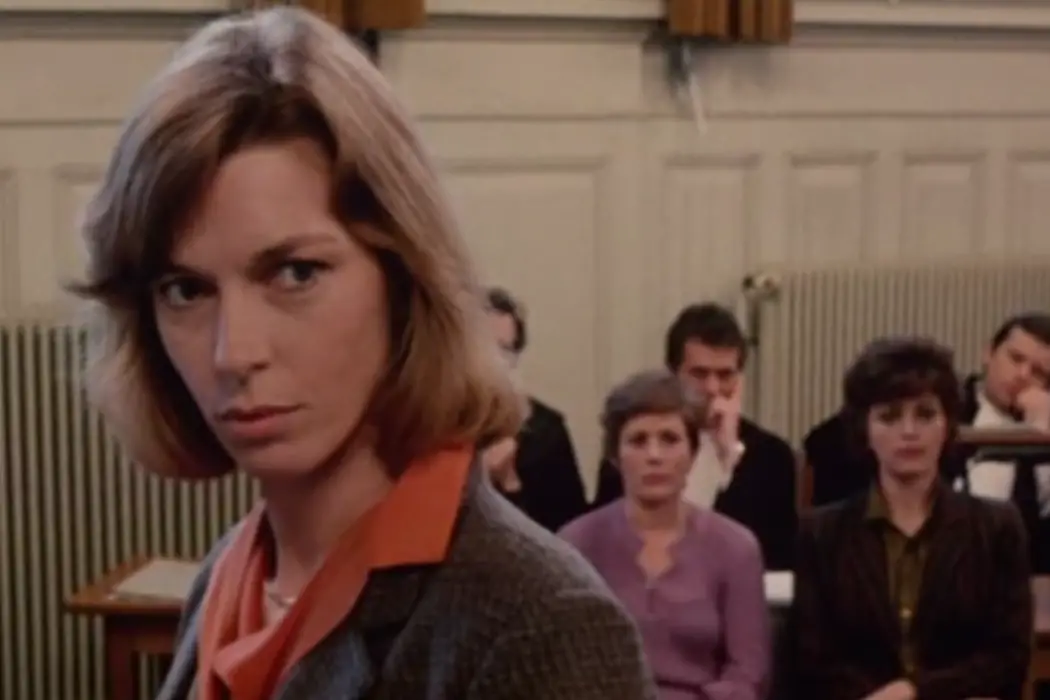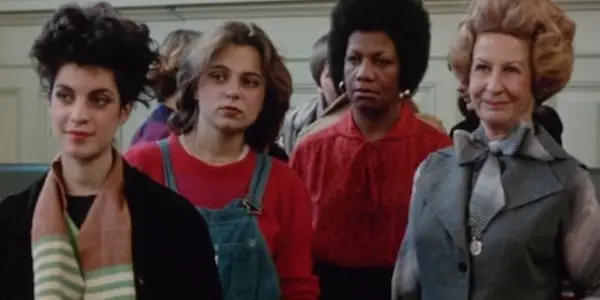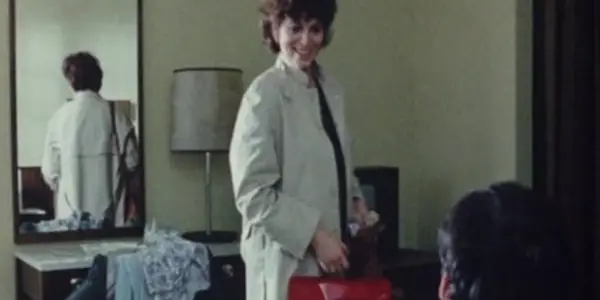A QUESTION OF SILENCE: Unquiet Revolt

Frances is a graduate of film and digital media from…
A Question of Silence is considered by many well-versed feminists and academics to be a classic of progressive cinema. So you might be wondering why you’ve never heard of it. It’s not your fault — it is nearly impossible to find in high quality, seeming to exist only in VHS quality on archive websites. Obscure, right?
Not exactly. Question is the nominee and winner of five national and international awards, including the Netherlands Film Festival’s highest accolade of the Golden Calf. Its director, Marleen Gorris, is a prolific filmmaker who won an Oscar for her most well-known film, Antonia’s Line. Yet much of her work remains unprocurable, especially her early pieces.
Despite its inaccessibility (and its poor preservation), A Question of Silence is a brilliant work of quintessentially 80s feminist media. Showcasing women’s slow-burning rage beside the offenses and brush-offs of men, the film expresses frustration cathartic to the audience through its recognition.
Controversial upon its release and still somewhat so now, Question does not shy away from the most brutal application of its themes. It hinges on a murder — a gruesome murder, apparently senseless, by three women. These women are strangers to each other and kill a male shopkeeper when he confronts one of them shoplifting. We follow a female psychiatrist as she interviews the women over several weeks to determine whether they are fit to stand trial for the murder.
Despite its blunt-sounding plot, Gorris uses her breakout film to deeply explore feminine rage through symbolism. Men are a stand-in for oppressive social norms and structures that women experience. Through expert framing and insightful characterization, Marleen Gorris is able to inject her audience with the rage and relief that her characters feel.
A Psychiatrist and Three Killers
A Question of Silence begins with Janine. She is a modern woman with a career as a psychiatrist, and her lawyer husband supports her work and respects her. She is called into work on a weekend to psychoanalyze the perpetrators of a heinous crime. On her way into the facility, a male acquaintance mentions that this should be an easy case, as the murder was so gruesome that the perpetrators (three women) must surely be insane.
Janine, meeting each woman for the first time, is perplexed. They seem like fairly ordinary women despite their lack of remorse for the innocent man they killed.
First, she meets Christine, a housewife, who does not speak to anyone. The waitress Ann, on the other hand, talks to Janine about everything from work gossip to her home life. The third accomplice, Andrea, is perhaps the most self-aware in her intentions. She is a highly competent secretary for a generic authority figure at an international business firm.
Through recurring flashbacks, we find that Andrea was routinely silenced, quite literally, at her job. Her superiors (all men) don’t recognize her as a respectable human, so they have no self-awareness of their repression. When questioned about her mental state, Andrea’s boss only says that she was always on time.

When Janine probes at Andrea’s motivations to kill a stranger, she asks her why she killed the shopkeeper in particular, and whether it could have been another man. Andrea responds to each, “Why not?”
While Andrea turns her silencing into rage and disdain for men, we see the opposite reaction to this long-term repression in Christine. Described by her husband as “quiet, not having much to say,” Christine’s years-long complete silence is not noted until she is in psychiatric custody.
Despite Janine’s best efforts to find a Freudian or traumatic basis for her clients’ actions, she comes out empty-handed. Their fathers did not beat them; they are not working from ideology; no one man has done them gravely wrong. Eventually, Janine is out of options: they must be sane, rational people. As she realizes this, she begins to see the same oppressions that her clients constantly experience in her own life.
Janine becomes troubled in her marriage. Finally noticing the ways that her husband doesn’t really see her as an equal, she pushes back, leading him into arguments as she becomes less subservient.
This culminates in sexual assault — though not understood as such by her husband. As he calls her to bed repeatedly despite her refusal, we hear the same music that was played over the murder of the shopkeeper. Janine’s face is intercut with footage of the shop, her three clients standing among the storefront mannequins. As we cut to Janine waking up, we see her full sympathy for and understanding of her clients.
When Janine, at last, presents her case to the court at the murder trial, she is ridiculed by the male judge and prosecutor. They see no sense in her verdict of sanity, saying to her that “from a psychiatrist, even a woman, one might expect an objective attitude.” Objective to them, as Janine points out, of course, means what fits with their own worldview.
There are no direct witnesses of the murder (who admit to it; several other women were there, but they do not come forward). The only testimony comes from men who were around the shop at the time and saw what happened before and after the scene. It is of course not an accident that no women will testify.
As the men running the proceedings continue to pester Janine, pushing her to deem her clients insane or at least condemn them for their actions, she becomes frustrated. She eventually asks them whether they realize that gender had something to do with it. Of course not, they say, it would be exactly the same if three men had killed a woman.
At this, Ann begins to laugh. Andrea and Christine shortly join her, then do the female bystanders from the shop — who have joined the court audience seemingly in solidarity. Even Janine joins in as men attempt to quiet them.

After a long minute, the laughing women are forced to leave the courtroom — Janine, to the surprise of the judges, following them out. As her husband calls to her from the car, she glances between him and the women witnesses who left with her. She smiles at them, abandoning her husband.
Metaphorical Murder
To truly understand this film, it must be understood as a metaphor. As such, practically all of its male characters are caricatures. This also explains why the morality of the central murder is never really considered. Odd as it may sound, the murder is not the point.
The men in A Question of Silence are not real men. This is quite shocking to some reviewers (see its IMDB reviews sorted by least helpful), who condemn the director for man-hating and calling for the murder of innocent men. Rather, men serve as symbols in this film — in the same way, noticeably, that women are used as maternal stand-ins or sex objects, personality-boosters, or plot devices, in films much more famous than this one.
As symbols of oppression and patriarchy, men in Question have no internal beliefs or motives other than those held by their representative structures. We are not intended to sympathize with them. We watch them disregard and abuse women to their breaking points, and when women take vengeful action in turn, they are destroying the structures that have destroyed them. By condensing patriarchal and abusive structures into male characters, Gorris is able to make the audience feel as objectified, ignored, and stifled as her characters, who have endured — perhaps subtler — offenses for their entire lives.
After Ann, Andrea, and Christine kill the shopkeeper, each of them has a small, impromptu celebration of sorts. Christine, leaving with her baby, stops at a fair and takes a ferris wheel ride with the child. Ann cooks herself a decadent French banquet for dinner. Andrea is mistaken for a sex worker and plays along, having sex with a male stranger for an exorbitant fee.
At its surface, Andrea’s celebration of victory against the patriarchy doesn’t exactly seem fitting. However, Andrea is not an ordinary woman, and her perspective sets this apart from a typical exploitative encounter. Upon noticing the stranger’s interest in her, she smirks at him, and when he asks “how much?” she quotes what must be an unthinkably high charge.
After balking, he agrees, and Andrea proceeds to have sex with him fully on her terms. That is, she does not undress, does not let him touch her, and remains basically sitting until she chooses to leave. As she is leaving, she stares at him for a moment and laughs.

This laughter demonstrates Andrea’s disdain for this stranger and her spiteful pleasure in using his sexual desire as her monetary gratification. Symbolically speaking, she is using a system of oppression for her own benefit.
Ann and Christine, though they act out in subtler ways, are similarly enjoying their (temporary) conquest of the patriarchy. Though technically it overpowers them by the end of the film, throwing them out of the courtroom, the women have the metaphysical advantage. Their laughter is something the men in the room cannot understand or control: it is their solidarity and their refusal to remain silent.
Unquestionably Important
A Question of Silence is, in many ways, a difficult film to accept into polite society. It is blunt and even brutal in its application of the themes of oppression and silence. It can be uncomfortable to watch, but the final scene imparts a powerful relief through the laughter of the women who are, in their own way, escaping their repressed lives.
Question is also difficult in its lack of total relatability. By framing men as tools of an unsympathetic hierarchy, it dismisses some real-life men, who might hesitate to view other men this way, from its possible demographic. For example, in addition to being portrayed as fairly cruel, men in this film are never aware of the violence they inflict. We see this in just about every interaction a woman has with a man onscreen, from casual dismissal to sexual assault.
However, the film is ultimately successful in its goal, which is not to be massively popular. Rather, it demonstrates the social awakening and solidarity of women in the face of everyday oppressions unnoticeable to many men and women alike. We see this transformation through Janine, who is unaware of her own subordinate position in a gendered hierarchy until realization is forced upon her by her three clients.
Marleen Gorris attempts to poke holes in a system perceived by many as natural, and judging by her film’s numerous accolades, she succeeds. Despite its unfortunate inaccessibility, A Question of Silence is an important work that delivers rage, catharsis, and the hope for solidarity.
What are your favorite feminist films? Let us know in the comments!
A Question of Silence is available at archive.org and occasionally on YouTube.
Watch A Question of Silence
Does content like this matter to you?
Become a Member and support film journalism. Unlock access to all of Film Inquiry`s great articles. Join a community of like-minded readers who are passionate about cinema - get access to our private members Network, give back to independent filmmakers, and more.
Frances is a graduate of film and digital media from California. She enjoys watching and expounding theories on cinema, especially when experimental or directed by women. In her spare time she enjoys reading short stories and writing queer fantasy.













